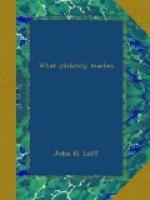[Illustration: Stamp, Brazil, “30”]
[Illustration: Stamp, “Hawaiian Postage”, 2 cents]
[Illustration: Stamp, “Loesen”, 1 ore]
[Illustration: Stamp, “Nederland”, 21/2 cent]
[Illustration: Stamp, “Danmark”, 5 ore]
[Illustration: Stamp, Arabic]
In other countries only inscriptions are used. This is especially the case with the Native States of India, in some of which as many as four languages are said to be employed on one stamp. These are interesting for their crude and curious designs but are not popular with collectors, probably because of our inability to read them.
[Illustration: Stamp, Arabic]
Afghanistan has varied the idea by placing on her stamps a tiger’s head surrounded by a broad circle of inscriptions. Owing to the short comings of native art the tiger is more often droll than ferocious.
The method of cancellation used in that country is crude but effective. It consists in cutting or tearing a piece out of the stamp. Needless to say, it is not popular with stamp collectors.
[Illustration: Stamp, Arabic, Hindi]
Jhalawar, one of the Native States of India, has also varied the monotony of inscriptions by the addition of a sort of jumping-jack figure. By some writers this is claimed to be a dancing dervish and by others a Nautch girl. As pictured on the stamp the figure does not present the sensuous outlines which have always been attributed to those delectable damsels. Bossakiewicz, in his Manuel du Collectionneur de Timbres Poste says: “A dancing nymph, belonging to the secondary order of Hindu divinities and known as an apsara.” Here is a problem which the next convert to philately may undertake to solve. You see there are still worlds to conquer, in spite of all the inky battles that have been waged by philatelic writers.
[Illustration: Stamp, “Diligencia”, 60 centavos]
[Illustration: Stamp, “Escuelas”, 1 centesimo]
The first stamps of Uruguay bear the inscription “diligencia” (stagecoach), thus plainly indicating the method then employed for transporting the mails. On some of the Venzuelan stamps is the word “escuelas” (schools), a portion of the revenue from this source being devoted to the maintenance of the state schools.
[Illustration: Stamp, “North Borneo”, 12 cents]
[Illustration: Stamp, “Obock”, 1893, 5 c.]
[Illustration: Stamp, “Sudan Postage”, 1 millieme]
[Illustration: Stamp, “Correo Lima”, 2 centavos]
[Illustration: Stamp, “Guatemala”, 20 centavos]
[Illustration: Stamp, “New South Wales”, 8 pence]
[Illustration: Stamp, “New South Wales”, 1 shilling]
[Illustration: Stamp, “Newfoundloand”, 5 cents]
[Illustration: Stamp, “Newfoundloand”, 2 cents]
[Illustration: Stamp, “Postage W. Australia”, 1 shilling]




